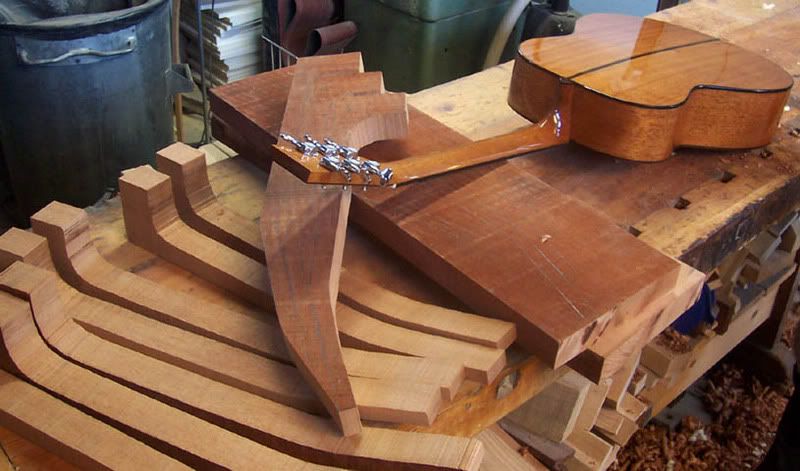I cut my 2-piece necks from large flat sawn boards. I like to keep them in rough sawn form for a while in case they want to move at all after they are cut. One thing I like to do when sawing up many blanks like this is to mirror the neck pattern along the length of the board, and I code each blank so I know where it was located in the board. This way I can mach each neck with so the two pieces will have similar grain. This means that when the neck is glued up, any movement in one of the pieces will be cancelled out by an opposite but equal movement in the other piece, giving a very stable neck. That's the theory, anyways.
Grain orientation: So far I have oriented the growth rings like this \\\///, others like to orient the grain this way, ///\\\ (fingerboard on top). Some have commented that the latter way may be better for resisting peeling stresses in the glue joint, and I guess that makes sense so I probably want to do that next time. I have not had any problems with the glue joint on these however; it is a pretty big gluing surface. Due to the geometry of the neck blanks after roughing sawing it can be difficult to plane the edges on these by hand before glue-up, so this is one joint where I use my large power jointer. I have also used a long belt sander, but I generally feel a planed edge is superior to a sanded one, so I prefer that when it is practical.
If I'm cutting up a 2" board I also slice a piece off the side from each billet for kerfed linings. This will reduce the billet to about 40 mm, which is fine for 2-piece necks. I make the linings by first sanding the thin off cut piece to 6 mm, I then kerf it on the table saw and next I slice it into individual linings. I plane these strips to a triangular shape with a block plane.
I have also made flat sawn necks from mahogany, and I have not noticed any more movement in these necks than the quarter sawn ones, so I’m not sure how much it matters. One thing to consider is that wood generally shrinks and expands more with humidity along the growth rings than across, so a neck would in theory move more in width if it was flat sawn rather than quartered. With nice and stable mahogany I don't think it is very noticeable. FWIW, Fender maple necks, violin necks and many mandolin necks are flat sawn.
I think I showed this pickture before, but what the heck...
